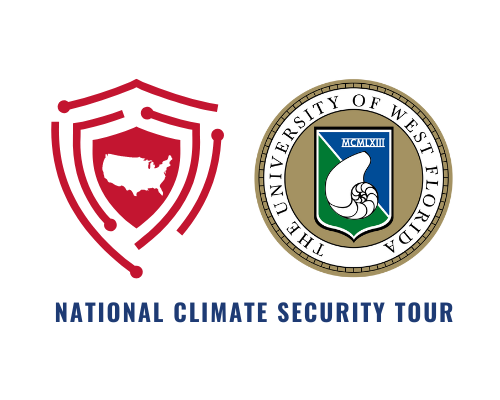
Event Recap: Climate Security in Northwest Florida — Best Practices and Lessons Learned for Military Facility Resilience
On April 24th, 2023, ASP hosted an esteemed panel with the University of West Florida to explore the key role Northwest Florida plays in enhancing national security, the consequences of climate insecurity, and climate resilience strategies for the communities that support U.S. military installations. Indeed, Northwest Florida is home to some of America’s most significant and simultaneously most vulnerable military installations, such as Pensacola Naval Air Station, Eglin Air Force Base, Hurlburt Field, and Tyndall Air Force Base, all of which the DoD ranks as among the most exposed to climate change in the entire country.
Moderated by Dr. Matthew Schwartz from the University of West Florida (UWF), panelists included:
- CAPT Tim Kinsella, USN (Ret.), the Director of the Aylstock, Witkin, Kreis & Overholtz Center for Leadership in the UWF College of Business and the former commanding officer of Naval Air Station Pensacola
- CAPT Rick Miller, USN (Ret.), who leads Pharos Mission Critical Solutions and the South Florida Defense Alliance
- Eric Christianson, a planner with the Emerald Coast Regional Council coordinating the Military Installation Resiliency Review for Eglin AFB, Hurlburt Field, Naval Air Station Pensacola, Naval Air Station Whiting Field, Naval Support Activity Panama City, and Tyndall AFB
- Laurie Murphy, the President of The Stormwater Training Center
- Dr. Brian Crisher, an Associate Professor in the Government Department at UWF
- Dr. Haris Alibašić, an Associate Professor and the Public Administration Program Coordinator at UWF
Eric Christianson began the conversation with his insights from the upcoming Military Installation Resiliency Review, including how base resiliency has become tethered to community resiliency. Military installations are no longer self-contained and self-sustaining facilities operating on endemic grids and networks; now, they rely on surrounding municipalities for everything from utilities to housing. Consequently, Christianson contended that sufficient military base resiliency requires DoD investment not only within its installations, but also in their surroundings.
Captain Miller elaborated on this topic by emphasizing the significance of Northwest Florida’s military installations. Indeed, the adjoining naval ranges and air corridors in more than 180,000 square miles of DoD controlled airspace extending out into the Gulf of Mexico are an invaluable and irreplaceable training asset for the U.S. military. Furthermore, Captain Miller detailed Florida’s unique position for responding to crises in Latin America and supporting military operations in Africa. Ultimately, Captain Miller warned that climate-induced extreme weather phenomena, flooding, and sea-level rise are costing the U.S. military its ability to project power, mission assurance and readiness, and billions of dollars in damaged facilities and equipment.
Captain Kinsella echoed these fears and added his experience repairing NAS Pensacola after a devastating hurricane. Much of the funding for base repairs is the “wrong color of money,” according to Captain Kinsella, meaning that it’s unavailable for improving structures above and beyond their prior condition. With the frequency of extreme weather events rising, it’s unproductive to repeatedly “band aid” damaged facilities rather than future-proofing them once. Captain Kinsella also warned that NAS Pensacola, which trains 60,000 aviators and naval technicians every year — a mission where failure is impermissible — is extraordinarily vulnerable to the next major hurricane.
Laurie Murphy added that the depletion of integrated natural features in favor of “impervious surfacing” has complicated stormwater drainage planning. Long-term base planning should seek to divert water flows into soiled areas where water can eventually reach and recharge subterranean aquifers, but given the immediacy of climate threats, Murphy argued that military bases must prioritize “low-hanging fruit” solutions.
On this theme, Dr. Alibašić posited that climate change is transforming the U.S. military’s paradigm for threats, forcing them to think along longer time horizons.
To conclude, Dr. Crisher reminded the panel of the strategic “ripple effects” brought on by climate change. In addition to the military readiness issues discussed by Captain Kinsella and Miller, gradually rising seas are endangering American shipyards, which will in turn diminish or limit the available U.S. naval forces for strategic competition with China in the Indo-Pacific Ocean.






